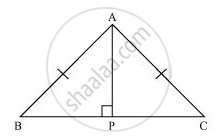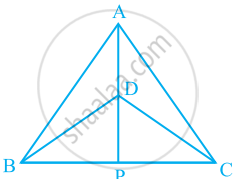Advertisements
Advertisements
प्रश्न
ABC is an isosceles triangle with AB = AC. Drawn AP ⊥ BC to show that ∠B = ∠C.
उत्तर

Given: ABC is an isosceles triangle
In which AB = AC
To prove: ∠B = ∠C
Construction: Draw AP ⊥ BC.
Proof: In ∆ABP and ∆ACP,
∠APB = ∠APC ...(Each 90°) ...(By construction)
AB = AC ...(Given)
AP = AP ...(Common)
ΔABP ≅ ΔACP ...(By RHS congruence rule)
Hence, ∠B = ∠C ...(Corresponding parts of congruent triangles)
APPEARS IN
संबंधित प्रश्न
ABC is a right angled triangle in which ∠A = 90° and AB = AC. Find ∠B and ∠C.
ΔABC and ΔDBC are two isosceles triangles on the same base BC and vertices A and D are on the same side of BC (see the given figure). If AD is extended to intersect BC at P, show that
- ΔABD ≅ ΔACD
- ΔABP ≅ ΔACP
- AP bisects ∠A as well as ∠D.
- AP is the perpendicular bisector of BC.

AD is an altitude of an isosceles triangles ABC in which AB = AC. Show that
- AD bisects BC
- AD bisects ∠A
Prove that in a quadrilateral the sum of all the sides is greater than the sum of its diagonals.
ABC and DBC are two triangles on the same base BC such that A and D lie on the opposite sides of BC, AB = AC and DB = DC. Show that AD is the perpendicular bisector of BC.
Prove that sum of any two sides of a triangle is greater than twice the median with respect to the third side.
Two lines l and m intersect at the point O and P is a point on a line n passing through the point O such that P is equidistant from l and m. Prove that n is the bisector of the angle formed by l and m.
Line segment joining the mid-points M and N of parallel sides AB and DC, respectively of a trapezium ABCD is perpendicular to both the sides AB and DC. Prove that AD = BC.
ABCD is a quadrilateral such that diagonal AC bisects the angles A and C. Prove that AB = AD and CB = CD.
ABCD is quadrilateral such that AB = AD and CB = CD. Prove that AC is the perpendicular bisector of BD.
